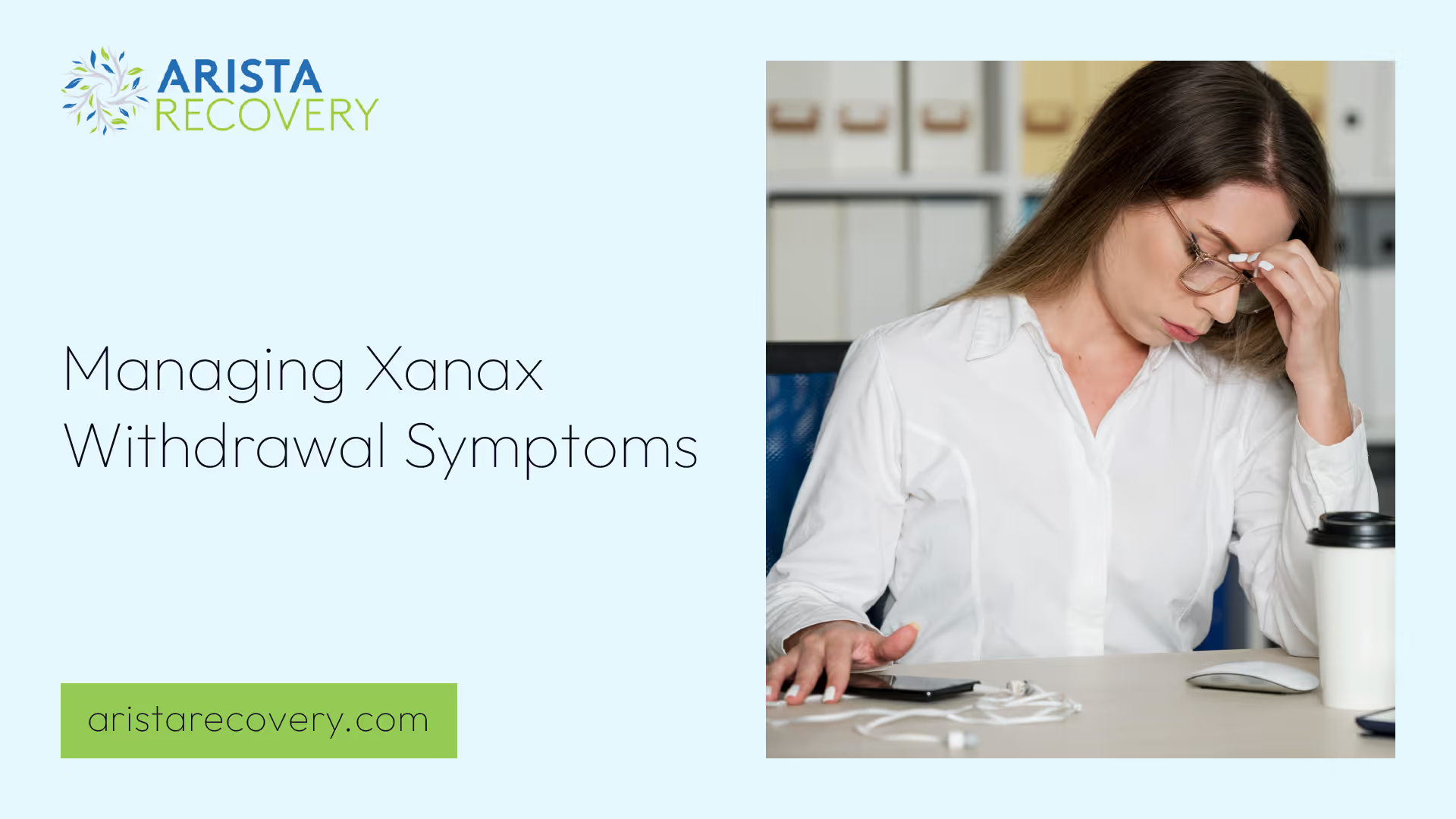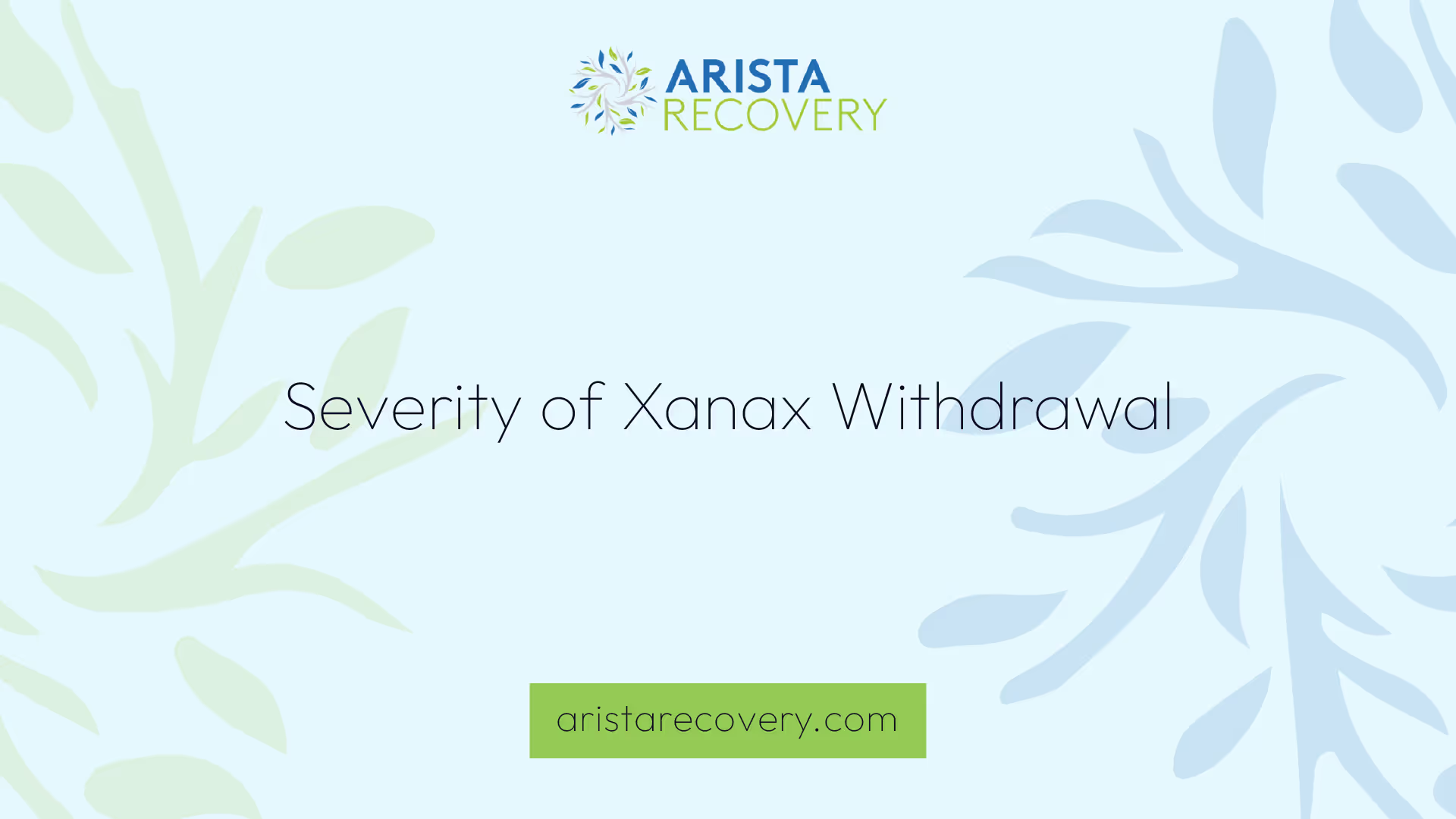Managing Xanax Withdrawal Symptoms


Understanding Xanax Withdrawal
The process of Xanax withdrawal is a crucial part of the journey towards recovery from addiction. It's essential to understand the onset and duration of withdrawal symptoms to better manage and navigate this challenging phase.
Onset of Symptoms
Xanax withdrawal symptoms typically appear within 8 to 12 hours of the last dose, according to Verywell Mind. This can vary depending on the individual's metabolism, the dosage and duration of use, and other factors. Symptoms can range from mild discomfort to severe physiological changes, making it crucial to have professional medical supervision during this period. For more details about the side effects of Xanax, see four Xanax side effects.
Duration of Withdrawal
The duration of Xanax withdrawal can also vary greatly between individuals. According to American Addiction Centers, withdrawal can begin within 24 hours after the last dose and symptoms may last between a few days to weeks. For those who have been using Xanax for 6 months or more, around 40% experience moderate to severe withdrawal symptoms when they stop taking the drug.
Moreover, acute symptoms can last longer, and protracted Xanax withdrawal can persist for up to one year in about 10% to 25% of long-term users, as per Verywell Mind.
Understanding the onset and duration of Xanax withdrawal symptoms is an essential step in the process of overcoming addiction. This knowledge can provide a sense of anticipation and preparedness, helping individuals navigate the challenges of withdrawal with more confidence and resilience.
For information on how to ease the discomfort of Xanax withdrawal symptoms, see how to ease Xanax withdrawal. Understanding the history of Xanax can also provide insight into its effects and withdrawal process. See the history of Xanax for more context.
Factors Influencing Xanax Withdrawal
Several factors can influence the experience of Xanax withdrawal, including the dosage and duration of use, concurrent use of multiple benzodiazepines, and the type of benzodiazepine used.
Dosage and Duration
The dosage and duration of Xanax use can significantly impact the severity and duration of withdrawal symptoms. Higher doses of Xanax and longer periods of use can lead to more intense withdrawal symptoms. There appears to be an increased risk of physiological dependence and severe withdrawal in patients that consume more than 4 mg of Xanax per day for 12 weeks or more. However, even lower doses, especially for longer periods, may still lead to withdrawal symptoms when the medication is discontinued [1].
Concurrent Benzodiazepine Use
Concurrent use of multiple benzodiazepines can also influence Xanax withdrawal. Using multiple benzodiazepines concurrently can intensify withdrawal symptoms and potentially prolong the withdrawal period due to the different half-lives and properties of the various drugs [1].
Type of Benzodiazepine
The type of benzodiazepine used can also play a role in the withdrawal experience. For example, shorter-acting benzos like Xanax can lead to a quicker onset of withdrawal symptoms compared to longer-acting benzodiazepines. Alprazolam withdrawal may be associated with higher instances of rebound anxiety compared to other benzodiazepines.
Understanding these factors can help individuals better prepare for the withdrawal process and seek appropriate support and treatment methods. It's important to remember that the process of overcoming Xanax dependence is not linear. Each person's journey with Xanax withdrawal is unique, and the process can be influenced by several factors. For more information about the history and effects of Xanax, visit our article on the history of xanax and four xanax side effects.

Severity of Xanax Withdrawal
The severity of xanax withdrawal symptoms can vary greatly among individuals. It's largely influenced by factors such as the dosage, duration of use, concurrent use of multiple benzodiazepines, and the specific type of benzodiazepine used.
Moderate Symptoms
Around 40% of people who have used Xanax for six months or more experience moderate to severe withdrawal symptoms when they stop taking the drug. Moderate symptoms of Xanax withdrawal often include anxiety, restlessness, and sleep disturbances. Other common symptoms include mood swings, trouble concentrating, and physical discomfort.
It's important to note that even at lower doses, especially when used for longer periods, withdrawal symptoms can still occur when the medication is discontinued.
Severe Symptoms
Severe symptoms of Xanax withdrawal are more likely to occur in individuals who have used higher doses of the medication, especially for prolonged periods. These can include severe anxiety and depression, hallucinations, and seizures.
In some instances, Xanax withdrawal may be associated with higher instances of rebound anxiety compared to other benzodiazepines. This is often characterized by the return of anxiety symptoms that are more intense than before the medication was started.
Protracted Withdrawal
In addition to the acute withdrawal phase, which typically lasts between 5 and 28 days, some individuals may experience a more protracted withdrawal phase. This phase, which can last up to a year or more in some cases, is characterized by new or worsening symptoms, such as anxiety and depression.
Studies indicate that between 10% and 25% of chronic benzodiazepine users experience protracted withdrawal when they stop taking the drug. This highlights the importance of seeking professional help when discontinuing the use of Xanax or other benzodiazepines.
The severity and duration of Xanax withdrawal symptoms can make the process challenging. However, with proper support and treatment strategies, individuals can successfully manage these symptoms and reclaim control over their health. For more information on how to ease Xanax withdrawal, visit our article on how to ease xanax withdrawal.
Management of Xanax Withdrawal
Managing Xanax withdrawal effectively is crucial to ensuring a safe and successful recovery from benzodiazepine dependence. This process typically involves tapering techniques, medications for withdrawal, and psychological support.
Tapering Techniques
Tapering is a key strategy in managing Xanax withdrawal. It involves the gradual reduction of Xanax dosage under the supervision of a healthcare professional. The best way to lessen the severity of Xanax withdrawal symptoms is by slowly tapering down the dose. This approach involves taking progressively smaller doses over several weeks, and switching from Xanax to a longer-acting benzodiazepine like Valium can assist in the tapering process.
Abruptly discontinuing benzodiazepines after a patient has been taking them daily for more than one month can be dangerous, as withdrawal can be severe or even life-threatening. Taper schedules should be individualized, considering factors such as lifestyle, personality, environmental stressors, reasons for taking benzodiazepines, and the amount of available personal and clinical support [3].
Medications for Withdrawal
Alongside tapering, certain medications can be used to aid in the management of Xanax withdrawal symptoms. Flumazenil, an antagonist of benzodiazepines, could help alleviate acute and protracted withdrawal symptoms. Other medications such as anticonvulsants, antidepressants, and beta blockers have shown efficacy in treating benzodiazepine withdrawal symptoms.
However, it's crucial to note that these medications should only be used under the guidance of a healthcare professional. Individuals experiencing difficulty reducing or stopping the dosage due to cravings, intolerable withdrawal symptoms, early refill requests, and a need for benzodiazepines to perform daily activities may benefit from a referral to an addiction specialist [3].
Psychological Support
In addition to physical management, psychological support plays a vital role in managing Xanax withdrawal. This can include counseling, cognitive-behavioral therapy, group therapy, and other forms of mental health support. This support can help individuals cope with cravings, learn alternative stress management techniques, and deal with potential triggers, contributing to a more successful recovery.
The journey of managing Xanax withdrawal symptoms can be challenging but with the right approach and support, it's possible to reclaim control. For more information on Xanax and its effects, you may refer to our article on the history of xanax. If you are experiencing Xanax withdrawal symptoms and are looking for ways to ease them, our article on how to ease xanax withdrawal might be of help.

Alleviating Xanax Withdrawal Symptoms
Managing and easing the discomfort of Xanax withdrawal symptoms is a crucial part of the recovery journey. Understanding these symptoms can assist individuals in better navigating through this challenging period.
Common Symptoms
Xanax withdrawal symptoms can encompass a wide range of physical and psychological effects. These may include headaches, insomnia, hyperventilation, muscle spasms, racing pulse, seizures, sweating, tremors, anxiety, delirium, depression, difficulty concentrating, feelings of unreality, hallucinations, panic attacks, and restlessness. It's important to note that about 40% of people taking benzodiazepines for more than six months may experience moderate to severe withdrawal symptoms. For more detailed information about these symptoms and their effects, visit our article on four Xanax side effects.
Acute vs. Protracted Withdrawal
Xanax withdrawal symptoms typically appear within 8 to 12 hours of the last dose, with the worst symptoms occurring on the second day. This phase is known as acute withdrawal, which can last between 5 and 28 days after stopping benzodiazepines [1].
However, for some individuals, these symptoms can persist for a longer duration. This is referred to as protracted withdrawal, which can last up to a year or more in about 10% to 25% of long-term users. This highlights the importance of professional guidance and support during the withdrawal process. For tips on managing these symptoms, refer to our page on how to ease Xanax withdrawal.
Rebound Anxiety
An important aspect of Xanax withdrawal is the occurrence of rebound symptoms. Rebound anxiety, in particular, is a common issue where symptoms like anxiety may reoccur after stopping the medication. This anxiety experienced during Xanax withdrawal can be more intense than before taking the medication, a phenomenon known as Xanax rebound anxiety.
Understanding the challenges of rebound anxiety can help individuals better prepare for this phase of withdrawal and seek appropriate help and support. Alprazolam withdrawal may be associated with higher instances of rebound anxiety compared to other benzodiazepines.
Alleviating Xanax withdrawal symptoms is a multifaceted process that requires comprehensive understanding and effective management strategies. By being aware of the potential challenges and adopting suitable coping mechanisms, individuals can successfully navigate the path to recovery.
Preventing Xanax Dependence
Preventing Xanax dependence is crucial to avoid the discomfort and potential dangers of Xanax withdrawal symptoms. It requires a comprehensive approach that includes adherence to treatment recommendations, exploration of nonpharmacologic therapies, and the use of benzodiazepines for short-term periods only.
Treatment Recommendations
The American Academy of Family Physicians highlights that the best way to prevent benzodiazepine dependence, especially among high-risk patients, is to adhere to treatment recommendations [3]. This includes taking the medication as prescribed, attending regular check-ups, and promptly reporting any side effects or changes in symptoms. For a deeper understanding of the drug and its effects, refer to the history of Xanax.
Nonpharmacologic Therapies
In addition to medication, nonpharmacologic therapies play a significant role in managing anxiety and insomnia, the common conditions for which Xanax is prescribed. These therapies can include cognitive-behavioral therapy, mindfulness-based stress reduction, relaxation techniques, and lifestyle modifications such as regular exercise and healthy sleep habits. Emphasizing these therapies can aid in symptom management and reduce reliance on benzodiazepines [3].
Short-term Benzodiazepine Use
Another key strategy in preventing Xanax dependence is limiting the duration of benzodiazepine use. If benzodiazepines are used, they should be prescribed for short-term, intermittent use, intermittent brief courses, or occasional doses. This approach can limit the potential for new, long-term users and reduce the risk of developing a dependence.
By following these guidelines, individuals can reduce their risk of Xanax dependence and the associated withdrawal symptoms. It's important to remember that any changes to medication use should be made under the guidance of a healthcare provider. If you're experiencing Xanax withdrawal symptoms, or are concerned about potential side effects, contact your healthcare provider for support and guidance.
References
[1]: https://americanaddictioncenters.org/withdrawal-timelines-treatments/xanax
[2]: https://www.verywellmind.com/xanax-withdrawal-4685921
[3]: https://www.aafp.org/pubs/afp/issues/2017/1101/p606.html
You’re not alone in this.
When mental health challenges and addiction intersect, it can feel isolating. At Arista, we offer compassionate, evidence-based, and trauma-informed care to help you heal, grow, and move forward.
Support that moves with you.
You’ve taken a brave first step. At Arista Recovery, we’re here to help you continue with best-in-class care designed for long-term healing and support.
.webp)






